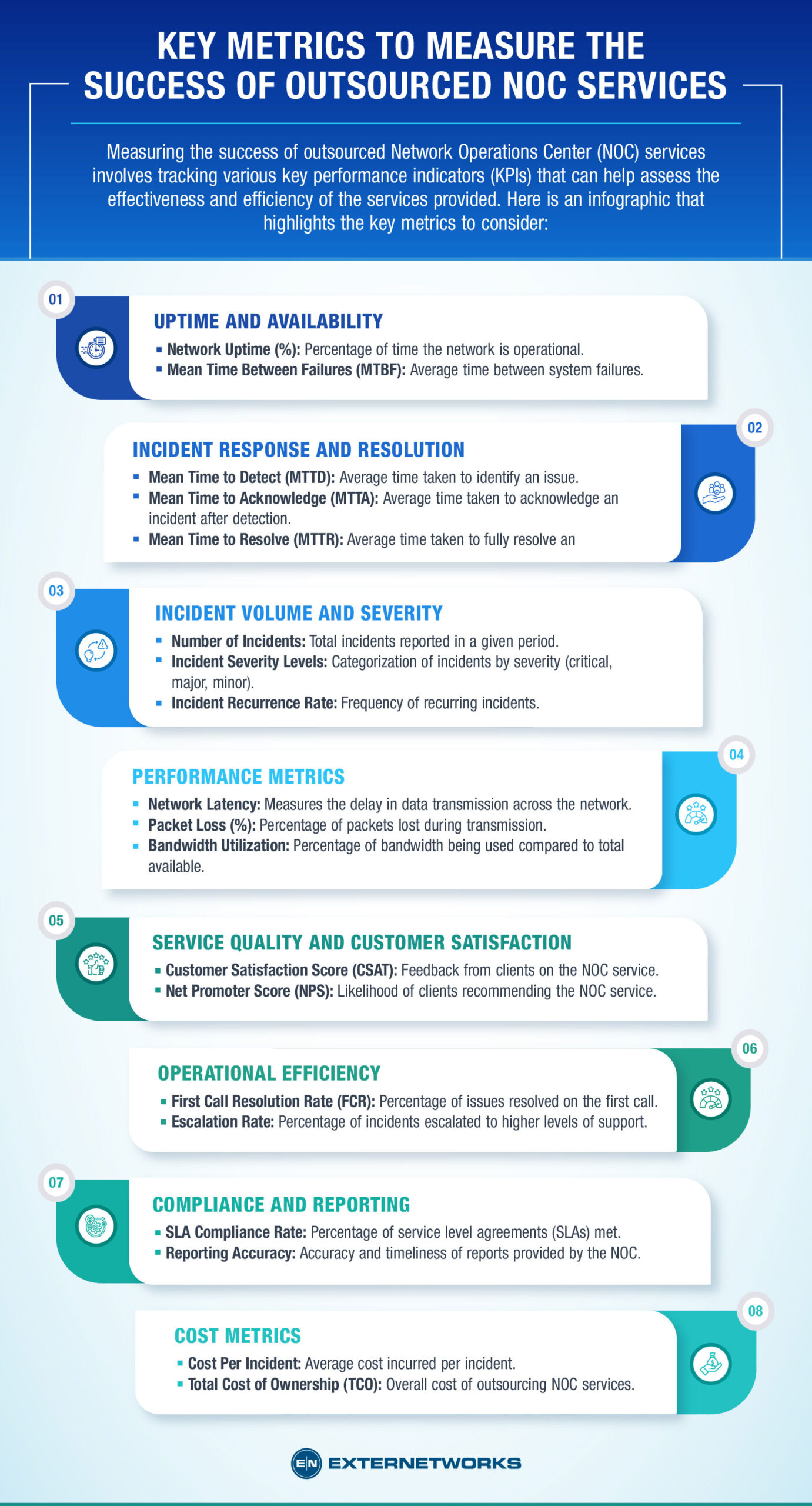Key Metrics to Measure the Success of Outsourced NOC Services

Outsourcing network operations center (NOC) services can bring many benefits to businesses, such as improved network performance and reduced operating costs. However, simply outsourcing these services is not enough to ensure success. To truly measure the effectiveness of your outsourced NOC services, you need to track and analyze key metrics.
By monitoring these metrics, you can gain valuable insights into the performance of your NOC provider and make informed decisions to optimize your network operations. In this article, we will discuss the key metrics that you should be tracking to measure the success of your outsourced NOC services.
Key Metrics to Measure the Success of Outsourced NOC Services
Outsourcing Network Operations Center (NOC) services have become a strategic move for many organizations looking to streamline their IT operations, enhance network performance, and reduce costs. However, the effectiveness of these outsourced services must be meticulously measured to ensure they meet the organization’s needs and contribute to its overall goals. Here, we delve into the key metrics that can be used to measure the success of outsourced NOC services.
1. Incident Response Time
One of the primary functions of a NOC is to respond to incidents that affect network performance. The speed with which these incidents are addressed is crucial. Incident response time can be broken down into:
- Detection Time: The time it takes to identify an issue from the moment it occurs.
- Acknowledgment Time: The time it takes for the NOC to acknowledge the incident after it has been detected.
- Resolution Time: The time it takes to resolve the issue from the moment it is acknowledged completely.
These metrics help determine how efficiently the NOC can mitigate issues and minimize downtime, directly affecting the business’s productivity and customer satisfaction.
2. Mean Time to Repair (MTTR)
MTTR is a critical metric that measures the average time required to repair a failed component or system and restore it to operational status. A lower MTTR indicates that the NOC resolves issues quickly, minimizing downtime and associated costs.
3. Mean Time Between Failures (MTBF)
MTBF measures the average time between failures of a system or network component. This metric helps understand the network’s reliability. A higher MTBF indicates that the network is stable, and the NOC is effectively maintaining the infrastructure to prevent frequent outages.
4. First Call Resolution (FCR)
FCR is the percentage of incidents resolved during the initial contact with the NOC. A high FCR rate is a strong indicator of the NOC’s efficiency and the competence of its staff. It shows that issues are being handled promptly without the need for escalations or multiple interactions.
5. Network Uptime
Network uptime is a direct measure of the network’s availability and reliability. This metric is typically expressed as a percentage of the total available time that the network is operational. High network uptime signifies that the NOC successfully maintains continuous network operations, which is crucial for business continuity.
6. Service Level Agreement (SLA) Compliance
SLAs are contracts that outline the expected performance and service standards agreed upon by the service provider and the client. SLA compliance metrics track whether the NOC meets these agreed standards. This includes parameters such as uptime guarantees, response times, and resolution times. Consistent compliance with SLAs reflects the reliability and accountability of the outsourced NOC services.
7. Customer Satisfaction (CSAT)
CSAT scores measure the satisfaction level of end-users or clients with the NOC services. This can be gauged through surveys and feedback forms following the resolution of incidents or periodic assessments. High CSAT scores indicate that the NOC is meeting or exceeding customer expectations in terms of service quality and support.
8. Ticket Volume and Trends
Analyzing ticket volumes and trends can provide insights into the network’s overall health and the NOC’s effectiveness. Metrics to consider include:
- Total number of tickets: Understanding the total incident volume can help assess the workload and resource requirements.
- Ticket trends: Identifying patterns in incidents, such as recurring issues or peak times for incidents, can help in proactive network management and capacity planning.
- Ticket backlog: The number of unresolved tickets can indicate whether the NOC is overwhelmed or under-resourced.
9. Cost Savings and ROI
One of the main reasons organizations outsource NOC services is to reduce operational costs. Measuring the cost savings achieved through outsourcing compared to maintaining an in-house NOC is essential. This includes:
- Direct cost savings: Reduction in staffing, infrastructure, and training expenses.
- Indirect cost savings: Benefits from improved network performance, reduced downtime, and enhanced customer satisfaction.
Return on Investment (ROI) metrics can help in evaluating the financial benefits against the costs of outsourced NOC services.
10. Quality of Service (QoS) Metrics
QoS metrics assess the overall performance and reliability of the network services provided. These include:
- Latency: The time taken for data to travel from source to destination. Lower latency indicates better network performance.
- Jitter: The variation in packet arrival times. Lower jitter is crucial for real-time communications.
- Packet loss: The percentage of packets lost during transmission. Lower packet loss indicates a more reliable network.
11. Employee Training and Certification Levels
The expertise and proficiency of the NOC staff play a significant role in the quality of service provided. Metrics related to the training and certification levels of NOC employees can indicate the competence and preparedness of the team to handle complex network issues. Regular training and up-to-date certifications are signs of a capable NOC provider.
12. Proactive Monitoring and Maintenance
The NOC’s proactive measures to prevent issues before they occur indicate their commitment to maintaining optimal network performance. Metrics to consider include:
- Number of proactive alerts: The number of potential issues identified and resolved before they impact the network.
- Preventive maintenance tasks: The frequency and effectiveness of maintenance activities performed to ensure network health.
13. Scalability and Flexibility
As businesses grow, their network requirements evolve. A crucial success metric is the ability of the outsourced NOC services to scale and adapt to changing needs. This includes the NOC’s ability to handle increased network traffic, new technologies, and additional services without compromising performance.
14. Security Incident Management
In today’s digital landscape, network security is paramount. Metrics related to security incident management help evaluate the NOC’s effectiveness in protecting the network. These include:
- Number of security incidents detected and resolved: A lower number of incidents may indicate robust security measures, while a higher number resolved quickly shows the NOC’s effectiveness in handling threats.
- Time to detect and respond to security breaches: The quicker the detection and response, the better the protection against potential damage.
15. Innovation and Continuous Improvement
The ability of the NOC to innovate and continuously improve its services is a key differentiator. Metrics in this category include:
- Adoption of new technologies: The speed and efficiency with which the NOC integrates new technologies and best practices into their operations.
- Process improvements: Implementing new processes and improvements to existing ones based on feedback and performance analysis.

Why is it Important to Track KPIs for Outsourced NOC Services?
Tracking Key Performance Indicators (KPIs) for outsourced Network Operations Center (NOC) services is crucial for several reasons:
- Performance Evaluation: KPIs provide objective measures to evaluate the effectiveness and efficiency of outsourced NOC services. They offer insights into how well the service provider meets the organization’s needs and expectations.
- Quality Assurance: By monitoring KPIs, organizations can ensure that the outsourced NOC service maintains a high-quality standard in network infrastructure management. This helps identify any deviations from agreed-upon service levels and address them promptly.
- Continuous Improvement: Tracking KPIs facilitates ongoing performance analysis and identifies areas for improvement. Organizations can implement corrective actions and optimize processes for better outcomes by identifying weaknesses or inefficiencies in the NOC service.
- Cost Optimization: Effective monitoring of KPIs helps in assessing the value derived from the outsourced NOC services relative to the associated costs. Organizations can identify opportunities to optimize resource allocation and minimize unnecessary expenditures.
- Risk Management: KPIs serve as early warning indicators for potential issues or risks in network operations. By monitoring metrics related to downtime, incident response times, and security incidents, organizations can proactively mitigate risks and prevent disruptions to business operations.
- Vendor Management: Tracking KPIs provides organizations with actionable data to assess the performance of their outsourced NOC service provider. It enables informed decision-making regarding vendor selection, contract negotiations, and ongoing vendor management activities.
- Alignment with Business Objectives: KPIs ensure that outsourced NOC services are aligned with the organization’s strategic goals and objectives. By measuring performance against predefined targets, organizations can verify that the NOC service contributes positively to overall business outcomes.
- Customer Satisfaction: Ultimately, the success of outsourced NOC services is reflected in the satisfaction of internal stakeholders and end-users. By monitoring KPIs related to incident resolution times, service availability, and customer feedback, organizations can gauge the level of satisfaction and make necessary improvements to enhance the user experience.
Tracking KPIs for outsourced NOC services is essential for evaluating performance, driving continuous improvement, managing risks, and ensuring alignment with business objectives. It enables organizations to optimize the value derived from outsourcing while maintaining a high standard of service delivery and customer satisfaction.
Why Choose ExterNetworks for Outsourced NOC Services
Choosing the right provider for Network Operations Center (NOC) services is crucial for ensuring optimal network performance, security, and reliability. ExterNetworks stands out as a leading provider in this space, offering a range of benefits that make it an excellent choice for businesses seeking outsourced NOC services. Here are key reasons to choose ExterNetworks:
- Expertise and Experience: ExterNetworks has a team of highly skilled and experienced professionals who are well-versed in the latest technologies and best practices in network operations. Our team has extensive experience in managing complex network environments and is equipped to handle any challenges that may arise.
- Proactive Monitoring and Support: ExterNetworks offers 24/7 proactive monitoring and support for network infrastructure, ensuring quick response to incidents and minimizing downtime. Our NOC services are designed to prevent issues before they escalate, providing peace of mind to our clients and enabling them to focus on their core business activities.
- Cost-Effective Solutions: ExterNetworks offers cost-effective solutions for outsourced NOC services tailored to each client’s specific needs and budget constraints. Our flexible pricing models ensure that organizations get the most value out of their investment in network infrastructure management.
- Customized Service Level Agreements (SLAs): ExterNetworks works closely with clients to develop customized Service Level Agreements (SLAs) that align with their specific goals and objectives. Our SLAs are designed to ensure that our clients receive the level of service they expect, with clear metrics and KPIs to measure performance.
- Advanced Technology and Tools : ExterNetworks leverages state-of-the-art technology and tools to provide efficient and effective NOC services. Their use of advanced monitoring and management platforms ensures real-time visibility into network performance, quick issue detection, and proactive maintenance to prevent problems before they impact operations.
- Scalability and Flexibility: ExterNetworks offers scalable and flexible solutions for outsourced NOC services, allowing organizations to easily adjust their service levels as their needs evolve. Whether it’s expanding operations, implementing new technologies, or responding to changes in the market, ExterNetworks can adapt its services to support the growth and success of its clients.
Conclusion
Measuring the success of outsourced NOC services involves a comprehensive approach that includes various performance, efficiency, and customer-centric metrics. By regularly monitoring and analyzing these key metrics, organizations can ensure that their outsourced NOC services deliver the desired outcomes, contribute to overall business objectives, and provide a reliable and high-performing network infrastructure.
Incorporating these metrics into regular performance reviews and service evaluations helps maintain transparency and accountability between the service provider and the client. This fosters a productive partnership and drives continuous improvement and innovation in network management practices.
to Contact Us




